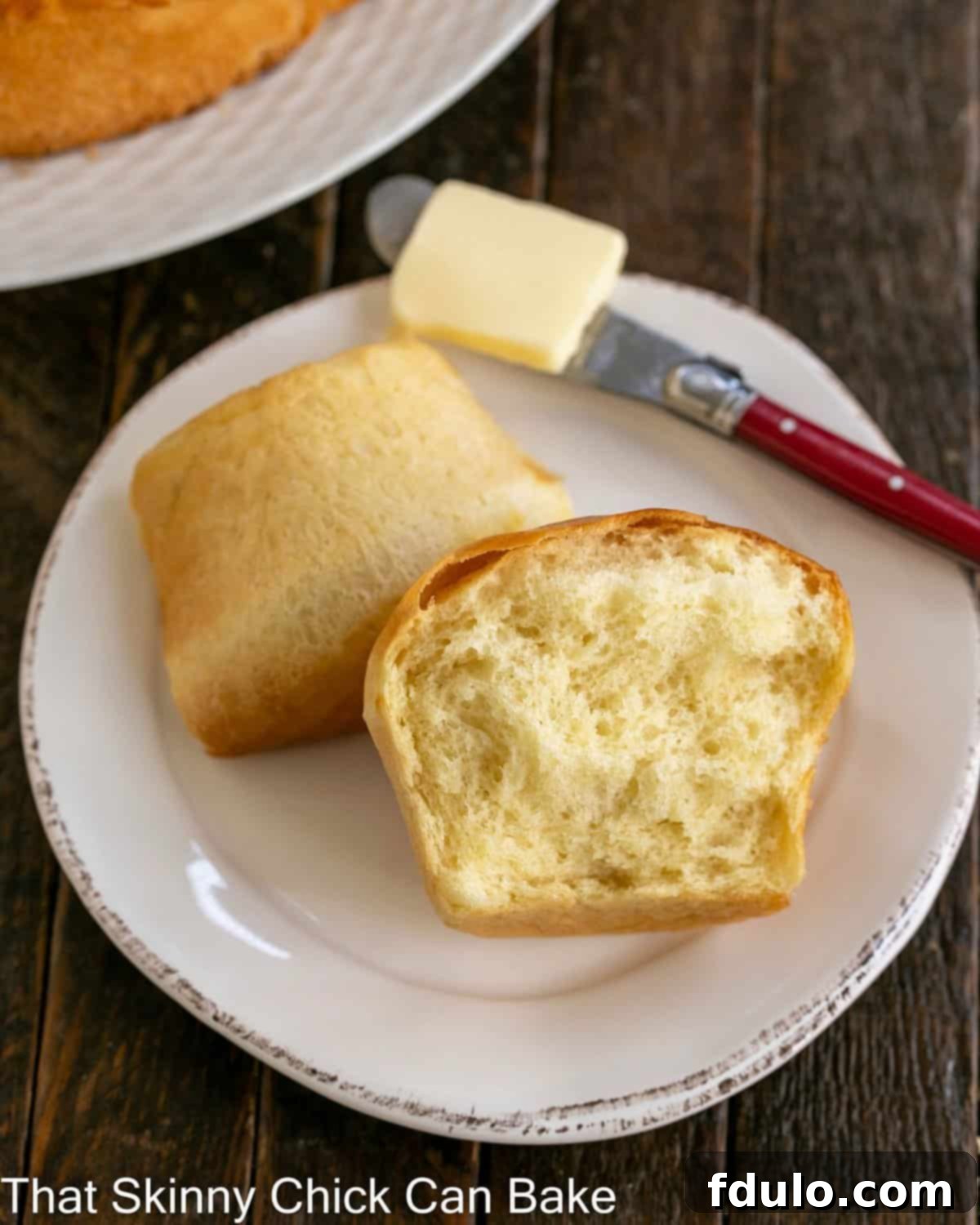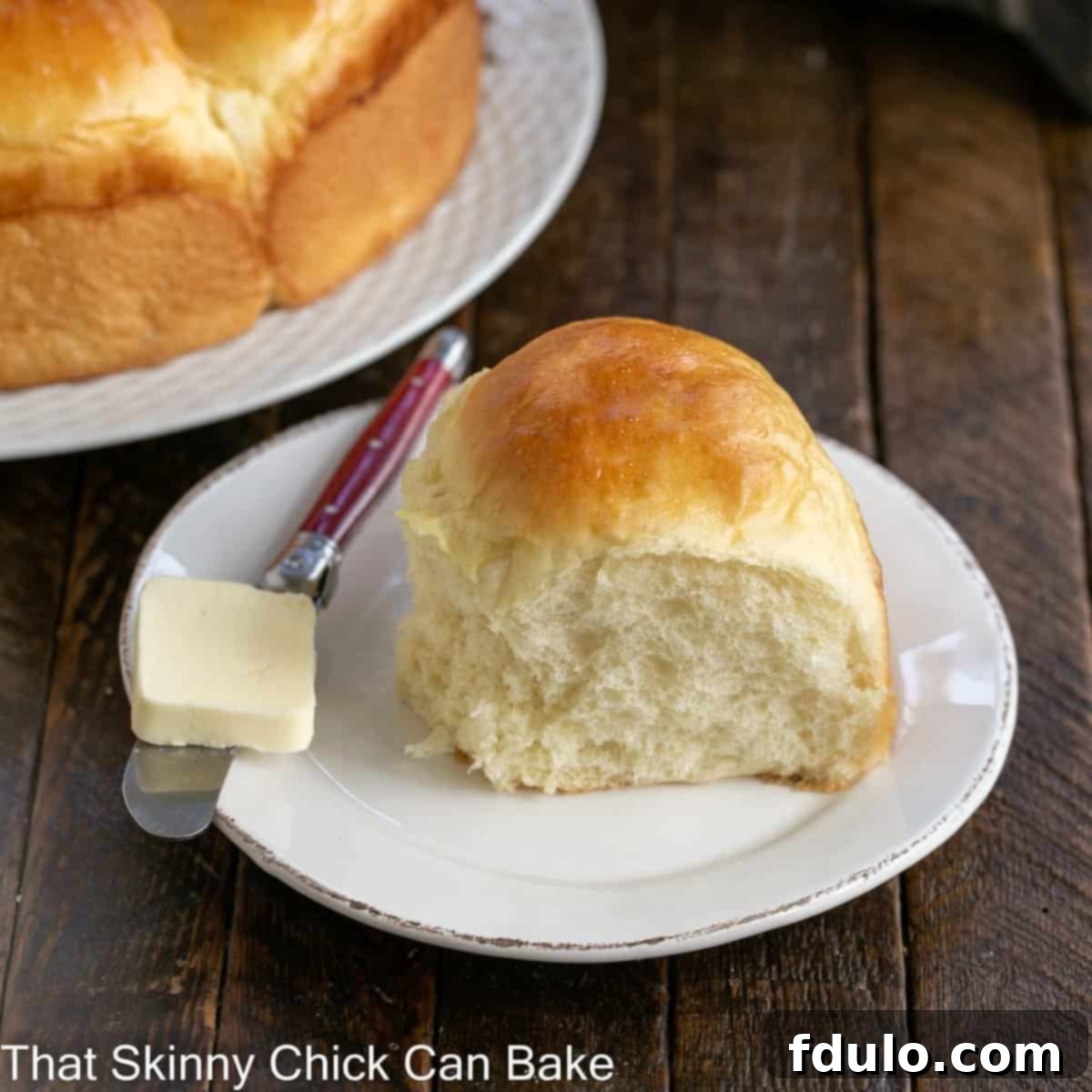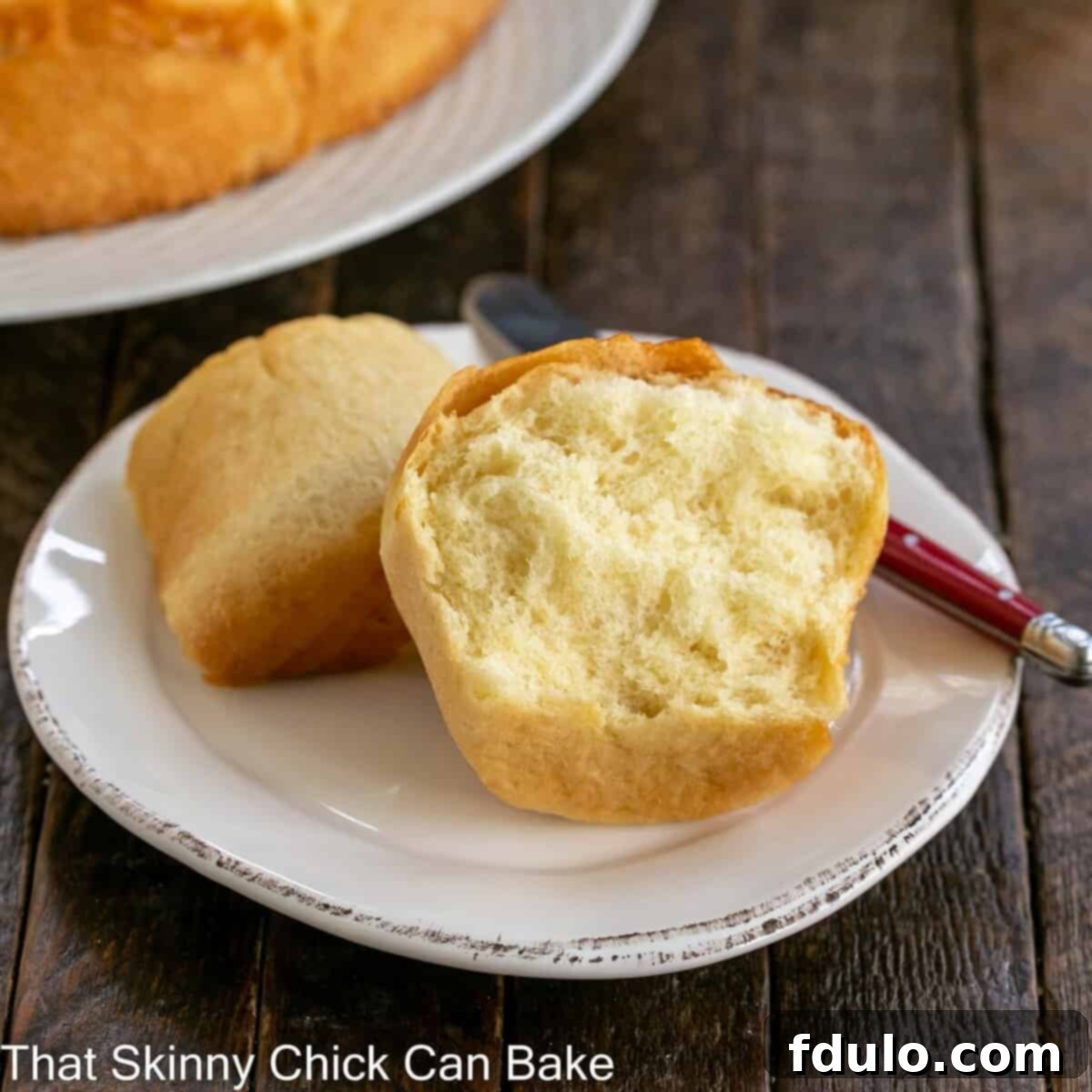Experience Unparalleled Softness with Japanese Milk Bread (Shokupan)
Prepare to embark on a culinary journey to discover the magic of Japanese Milk Bread, often known as Shokupan. This isn’t just any bread; it’s a sublime creation renowned for its extraordinary softness, delicate texture, and subtle milky sweetness. Whether shaped into fluffy rolls, a versatile loaf, or delightful buns, each bite promises an unforgettable experience that elevates any meal. The true secret behind this bread’s ethereal quality lies in a simple yet ingenious technique: tangzhong, a flour and water roux that transforms ordinary dough into something truly remarkable. Once you taste the delicate, cloud-like texture of these rolls, you’ll understand why this recipe is destined to become a beloved staple in your kitchen.

Why You’ll Fall in Love with These Japanese Milk Buns
Baking Japanese Milk Bread is more than just making a batch of rolls; it’s an adventure into the art of bread making that yields truly spectacular results. Here’s why this recipe will capture your heart and palate:
- Unmatched Softness: Get ready for the softest, most pillowy bread you’ve ever baked. This isn’t an exaggeration; the texture is famously light and airy, melting in your mouth with every bite.
- Master the Tangzhong Technique: You’ll learn the revolutionary tangzhong method, a pre-cooked flour and water paste that is the key to this bread’s unique tenderness and incredible ability to stay fresh for days longer than conventional breads. Understanding tangzhong will unlock a new level of bread baking for you.
- Versatile and Addictive: Once you experience the delightful taste and texture, you’ll find yourself making this bread again and again. These rolls are perfect for breakfast, as a side with dinner, for sandwiches, or even as the base for sweet treats. Imagine making cinnamon rolls with this soft milk bread – a truly divine prospect!
- A Delightful Baking Experience: The process, while requiring a bit of patience, is incredibly rewarding. Watching the dough transform into these beautiful, golden buns is a joy, and the aroma filling your kitchen is simply irresistible.

How to Make These Irresistibly Soft Rolls
Creating these delightful Japanese Milk Bread rolls involves a few distinct steps, but each one contributes to their legendary softness. Here’s a simplified overview to guide you through the process:
- Prepare the Tangzhong: Begin by cooking flour and water in a small pan over the stovetop until it thickens into a paste. This crucial step is what makes the bread exceptionally soft. Allow it to cool completely before proceeding.
- Gather Ingredients: Precisely measure out all your ingredients. Baking, especially with a recipe like this, benefits greatly from accurate measurements.
- Combine Dough Ingredients: Add your activated yeast mixture, the cooled tangzhong, and all remaining dough ingredients (except butter) into a large mixing bowl or the bowl of a stand mixer.
- Mix and Knead the Dough: Using a dough hook attachment on a stand mixer, or by hand, mix until the ingredients are well combined and a soft dough begins to form. Gradually incorporate the softened butter, one tablespoon at a time, continuing to knead until the dough becomes incredibly smooth, elastic, and passes the windowpane test.
- First Rise (Bulk Fermentation): Place the kneaded dough in a lightly greased bowl, cover it, and allow it to rise in a warm spot until it has doubled in size. This usually takes about 1.5 hours.
- Deflate and Divide: Gently deflate the risen dough by pressing down on it to release the air. Then, divide the dough into 8-9 equal pieces. Using a kitchen scale ensures uniform rolls.
- Shape the Rolls: Shape each piece of dough into a smooth, round roll. This helps create a beautiful, even texture in the final product.
- Second Rise (Proofing): Arrange the shaped rolls in a greased cake pan, leaving a little space between each roll for expansion. Cover and let them rise again until they are visibly puffy and nearly doubled in size.
- Egg Wash and Bake: Before baking, brush the top of the risen rolls with a simple egg wash for a beautiful golden crust. Bake in a preheated oven as directed in the recipe card until golden brown and cooked through.
Expert Tips for Baking Perfect Japanese Milk Bread
Achieving the perfect Japanese Milk Bread is simple with these expert tips:
- Mastering Tangzhong Consistency: The tangzhong is ready when it resembles a thick, smooth paste, similar to paper mache glue. You’ll know it’s done when your spoon or whisk leaves clear trails in the mixture as you stir. It should be cooked gently to avoid burning.
- Yeast Awareness: This recipe typically calls for 1 tablespoon of active dry yeast, which is often more than what’s found in a standard single packet. Always check your yeast packaging. If you’re using instant yeast, the process is slightly different as it doesn’t always require pre-activation. However, for active dry yeast, proofing it in lukewarm water is essential to ensure it’s alive and active before adding to the dough.
- Precision in Measurement: Weigh Your Flour! For consistent and optimal results, especially with a delicate dough like Japanese Milk Bread, measuring flour by weight (grams) is highly recommended over volumetric measurements (cups). Flour can pack differently into cups, leading to variations in dough consistency. Using a kitchen scale ensures you have the precise amount of flour needed for a less sticky, perfectly manageable dough.
- The Right Flour for the Job: This bread is traditionally made with all-purpose flour, not high-protein bread flour. Using all-purpose flour contributes to the characteristic tender and soft texture, as bread flour would create a chewier crumb.
- Grease Your Pan Thoroughly: Ensure your baking pan is well-greased with butter. This prevents the rolls from sticking and allows them to release effortlessly, preserving their beautiful shape.
- Preventing Over-Browning: If you notice your bread browning too quickly during baking, gently tent it with aluminum foil. This will protect the tops from excessive browning while allowing the inside to continue baking to perfection.
- Confirm Doneness with Temperature: The most accurate way to know if your Japanese Milk Bread is perfectly baked is by checking its internal temperature. The rolls are done when a digital instant-read thermometer inserted into the center of a roll registers 190°F (88°C).

Frequently Asked Questions About Japanese Milk Bread
Yes, Shokupan is essentially the Japanese term for milk bread, meaning “eating bread.” While “Japanese Milk Bread” can refer to various forms like individual rolls, Shokupan specifically denotes a square, Pullman-style loaf often baked in a lidded pan. This method creates a perfectly uniform, soft, and fluffy loaf ideal for slicing and toasting, making it incredibly popular for sandwiches and breakfast in Japan.
Shokupan offers a subtly sweet and distinctly milky flavor profile, which is quite delightful on its own or paired with sweet or savory toppings. However, what truly distinguishes it is its remarkable texture: an incredibly soft, pillowy, and feathery crumb that practically melts in your mouth. It’s known for being light yet satisfyingly rich.
Typically, yes, Shokupan is a type of white bread. It’s made primarily with all-purpose flour, giving it a classic white interior. Sometimes, recipes may include eggs, which can impart a very slight yellowish tinge to the crumb, but it remains within the realm of white bread.
Tangzhong is a traditional Asian baking technique involving a water roux, which is a pre-cooked mixture of flour and liquid (usually water or milk). By cooking a small portion of the flour with liquid until it forms a thick, gelatinous paste, the starches in the flour pre-gelatinize. This allows the dough to absorb and retain significantly more moisture, leading to bread that is exceptionally soft, incredibly moist, and remains fresh for an extended period. It’s a game-changer for homemade bread.
Beyond the Bake: Serving & Storage Suggestions
Once your Japanese Milk Bread is baked to perfection, the possibilities are endless! Enjoy these rolls warm with a pat of butter and a sprinkle of sea salt, or with your favorite jam. They make an excellent side dish for any meal, elevate your breakfast experience, or can be transformed into gourmet sandwiches. For an ultimate treat, use them to make French toast or a bread pudding. To keep them fresh, store the cooled rolls in an airtight container at room temperature for up to 3-4 days. They also freeze beautifully for longer storage; simply thaw and reheat gently when ready to enjoy that fresh-baked taste.
You May Also Like:
- Classic Oatmeal Bread
- Whole Wheat Challah
- Homemade Pretzel Rolls
- More of my Yeast Bread Recipes
Stay in touch through social media @ Instagram, Facebook, and Pinterest. Don’t forget to tag me when you try one of my recipes! And if you love the results, please give it a 5-star rating in the recipe card.

Japanese Milk Bread Recipe
20 minutes
25 minutes
2 hours 15 minutes
2 hours 40 minutes
8 rolls
Soft, fluffy rolls that are a delicious addition to any meal.
Ingredients
Yeast Mixture
- 1 tablespoon active dry yeast
- ¼ cup lukewarm water, 98-105°F (37-40°C)
Tangzhong
- 2 tablespoons all-purpose flour
- 2 tablespoons water
- 4½ tablespoons milk
Dough
- 2⅓ cups or 380 grams all-purpose flour (It’s best to weigh your flour with this recipe)
- ¼ cup sugar
- 1 teaspoon salt
- ½ cup milk
- 1 large egg
- 3 tablespoons unsalted butter, at room temperature
Egg Wash
- 1 egg
- 1 tablespoon water
Instructions
- Add the active dry yeast into the lukewarm water, mix gently, and allow to sit for 10 minutes. The yeast is active if it blooms (expands and forms bubbles on the surface).
- In a small saucepan, combine the tangzhong ingredients (2 tablespoons flour, 2 tablespoons water, 4½ tablespoons milk). Cook over medium-low heat, stirring constantly, until a thick paste forms. It should resemble paper mache glue or a thick pudding. Remove from heat and let it cool completely to room temperature.
- In the bowl of a stand mixer fitted with the dough hook attachment, add your activated yeast mixture, the cooled tangzhong, and the remaining dough ingredients (2⅓ cups flour, ¼ cup sugar, 1 teaspoon salt, ½ cup milk, 1 large egg). Mix on low speed for about 5 minutes, or until a soft, shaggy dough forms.
- With the mixer still on low, add your softened butter, one tablespoon at a time, allowing each addition to be fully incorporated before adding the next. Once all the butter is added, increase the speed to medium and knead for another 10-15 minutes, or until the dough is very smooth, elastic, and passes the windowpane test (a small piece of dough can be stretched thin enough to see light through without tearing).
- Transfer the dough to a lightly greased bowl, turning it once to coat. Cover the bowl with plastic wrap or a clean kitchen towel and allow it to proof in a warm place (around 85°F/30°C is ideal) for 1 ½ hours, or until it has doubled in size.
- Gently punch down the dough to release the air. Turn the dough out onto a lightly floured surface. Portion the dough into 8 or 9 equal pieces (using a kitchen scale for precision, each piece should be about 70-75 grams for 8 rolls). Shape each piece into a smooth, round roll.
- Arrange the dough balls in a lightly greased 9-inch springform or cake pan, leaving approximately ⅓ inch (about 1 cm) between each roll to allow for expansion.
- Cover the pan loosely with plastic wrap or a clean towel and allow the rolls to rest for a second rise for another 45 minutes, or until they look puffy and have nearly doubled in size again.
- About 15 minutes before the end of the second resting period, preheat your oven to 350°F (175°C).
- In a small bowl, whisk together the egg and 1 tablespoon of water to create the egg wash. Gently brush the egg wash across the surface of the risen rolls.
- Bake for 20-25 minutes, or until the rolls are golden brown and an instant-read thermometer inserted into the center of a roll reads 190°F (88°C).
- Once baked, remove the pan from the oven and transfer the rolls to a wire cooling rack. Let them cool in the pan for 10-15 minutes before carefully removing them to finish cooling completely on the rack. Enjoy warm or at room temperature.
Notes
Adapted from kwokspots.com/
If all your dough balls don’t fit into your main pan, use a greased ramekin or two to bake any excess dough as single rolls.
For the most accurate assessment of doneness, ensure the internal temperature of the bread reaches 190°F (88°C) using an instant-read thermometer.
Recommended Products
As an Amazon Associate and member of other affiliate programs, I earn from qualifying purchases.
- Kitchen Scale
- Silicone Pastry Brush
- Thermapen Instant Read Thermometer
- KitchenAid KSM150PSER Artisan Tilt-Head Stand Mixer with Pouring Shield, 5-Quart, Empire Red
- 9-inch springform pan
Nutrition Information:
Yield:
8
Serving Size:
1 roll
Amount Per Serving:
Calories: 277Total Fat: 7gSaturated Fat: 4gTrans Fat: 0gUnsaturated Fat: 2gCholesterol: 60mgSodium: 330mgCarbohydrates: 46gFiber: 2gSugar: 8gProtein: 8g
Thatskinnychickcanbake.com occasionally offers nutritional information for recipes contained on this site. This information is provided as a courtesy and is an estimate only. This information comes from online calculators. Although thatskinnychickcanbake.com attempts to provide accurate nutritional information, these figures are only estimates.
Varying factors such as product types or brands purchased can change the nutritional information in any given recipe. Also, many recipes on thatskinnychickcanbake.com recommend toppings, which may or may not be listed as optional and nutritional information for these added toppings is not listed. Other factors may change the nutritional information such as when the salt amount is listed “to taste,” it is not calculated into the recipe as the amount will vary. Also, different online calculators can provide different results.
To obtain the most accurate representation of the nutritional information in any given recipe, you should calculate the nutritional information with the actual ingredients used in your recipe. You are solely responsible for ensuring that any nutritional information obtained is accurate.
HOW MUCH DID YOU LOVE THIS RECIPE?
Please leave a comment on the blog or share a photo on Pinterest
